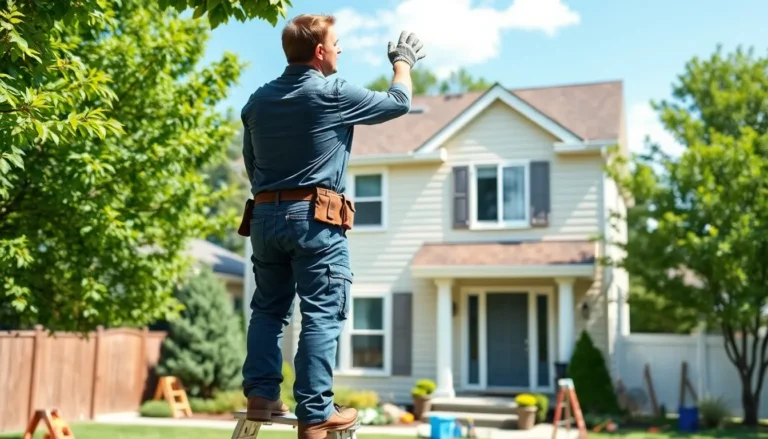Imagine walking into your home and having it greet you like an old friend. Smart homes aren’t just a futuristic fantasy; they’re the new normal. With a few clever installations, you can turn your humble abode into a tech-savvy haven that practically runs itself. But before you dive headfirst into the world of smart gadgets, there are some tips to keep in mind.
Table of Contents
ToggleUnderstanding Smart Home Technology
Smart home technology integrates devices that enhance living spaces through connectivity and automation. This integration not only improves convenience but also boosts energy efficiency.
Benefits of Smart Homes
Smart homes offer numerous advantages that simplify daily tasks. Enhanced security features, such as smart locks and cameras, provide peace of mind. Energy management through smart thermostats allows homeowners to optimize energy usage and reduce utility bills. Additional conveniences include voice-activated assistants that control various devices, scheduling features that streamline household routines, and real-time monitoring that caters to specific needs. Overall, adopting smart technology elevates the quality of life.
Common Components of Smart Home Systems
Various components contribute to effective smart home systems. Smart speakers serve as the central hub, enabling voice control of other devices. Smart lighting solutions include LED bulbs that adjust brightness and color based on preferences. Security cameras offer critical surveillance capabilities, while smart doorbells facilitate remote monitoring and communication. Smart thermostats adapt to occupants’ routines, enhancing comfort and savings. Each component plays a vital role in creating an interconnected living environment.
Planning Your Smart Home Installation
Smart home installation requires thoughtful planning. Specific strategies help in achieving a seamless integration of technology into the living space.
Assessing Your Needs and Goals
Identify unique requirements before starting. Consider current challenges like energy inefficiency or security concerns. Prioritize features that enhance convenience, such as smart lighting or automated thermostats. Evaluate lifestyle habits to find devices that truly fit. Research available options to gain insight into the latest smart technologies. For instance, families with pets may prioritize safety cameras, while tech enthusiasts might focus on advanced automation options.
Creating a Budget
Establish a clear budget to guide selection. Smart home devices vary significantly in price. Set aside funds for installation costs and any necessary upgrades. Identify essential gadgets that align with needs, then factor in additional costs for expanding the system later. Consider ongoing expenses, such as subscription services for features like cloud storage or premium support. Leverage discounts and sales to enhance value without overspending.
Choosing the Right Devices
Selecting the ideal smart home devices significantly influences functionality and satisfaction. It’s crucial to assess compatibility and popular options available in the market.
Compatibility with Existing Systems
Ensure devices integrate smoothly with current systems. Check compatibility with established platforms like Amazon Alexa, Google Assistant, or Apple HomeKit. Each ecosystem provides distinct features, and choosing a compatible device simplifies operation. Prioritize devices that communicate with existing gadgets. Consider Wi-Fi, Bluetooth, and Zigbee connectivity, as these protocols impact device performance. Thorough research helps avoid future connectivity issues and enhances user experience.
Popular Smart Home Devices to Consider
Explore various smart home devices based on specific needs. Smart thermostats improve energy efficiency and reduce costs. Smart lighting systems allow remote control and customization. Consider security cameras for added protection and monitoring. Smart speakers offer hands-free assistance and music playback. Smart doorbells ensure package delivery safety and visitor visibility. Evaluate each device’s functionality to determine its contribution to the overall smart home ecosystem. Making informed selections enhances home automation and convenience.
Installation Process and Best Practices
Smart home installation requires careful consideration of methods to ensure devices function effectively and improve daily life.
DIY vs. Professional Installation
Choosing between DIY and professional installation depends on individual skills and comfort levels. Many people prefer DIY for simple devices, as it saves costs and provides a hands-on learning experience. Installation of smart lights or plugs might appeal to those who enjoy tackling small projects. On the other hand, professional installation suits complex systems, like security cameras or complete smart home setups. Professionals offer expertise and can troubleshoot issues that arise during installation. Evaluating existing technical knowledge and the complexity of desired systems can guide this decision.
Step-by-Step Installation Tips
Start with reading the manufacturer’s instructions for each device. Familiarizing oneself with setup requirements can prevent common pitfalls. Next, gather all necessary tools to streamline the process. Consider creating a layout that accounts for device placement, ensuring optimal connectivity and coverage. Check the home’s Wi-Fi connection to support smart device functionality; strong networks prevent interruptions. Follow a specific order during installation to maintain organization, such as smart speakers followed by security devices. Lastly, test the installation after setup to confirm everything operates as intended. Tracking performance helps with identifying any adjustments that enhance integration.
Troubleshooting Common Issues
Smart home systems may encounter several common problems. Identifying and resolving these issues can ensure seamless operation.
Connectivity Problems
Connectivity issues often stem from weak Wi-Fi signals. Walls, appliances, and distance from routers can interfere with signals. To improve connectivity, repositioning routers or using Wi-Fi extenders may help. Likewise, checking device firmware for updates ensures compatibility with the network. Restarting the router can also resolve connectivity disruptions.
Devices connected to the 2.4 GHz band usually provide better range compared to the 5 GHz band. Ensuring devices are within range also plays a crucial role in maintaining stable connections. If connectivity problems persist, consider consulting the device manufacturer for tailored solutions.
Device Configuration Issues
Configuration problems can arise during the setup process. Users should ensure they follow manufacturer instructions accurately. Incorrectly entered credentials or settings often lead to malfunctioning devices. Verifying the correct app version for setup is critical, as outdated apps may limit functionality.
Connecting devices to the correct network also prevents issues. Checking the device’s compatibility with the smart home platform simplifies configuration. If multiple devices are being set up simultaneously, managing them one at a time can reduce errors and ensure a smoother integration process. Adjusting settings within the app can also enhance device performance.
Embracing smart home technology can significantly elevate daily living. By carefully planning and selecting the right devices, homeowners can create a seamless and efficient environment tailored to their needs. Prioritizing compatibility and functionality ensures that the integration of technology enhances convenience and security.
As challenges arise, understanding troubleshooting techniques can help maintain a smooth operation. With thoughtful installation and ongoing management, smart homes can truly transform ordinary spaces into extraordinary ones. By following these tips, individuals can enjoy the benefits of a connected lifestyle while maximizing the potential of their smart home systems.




